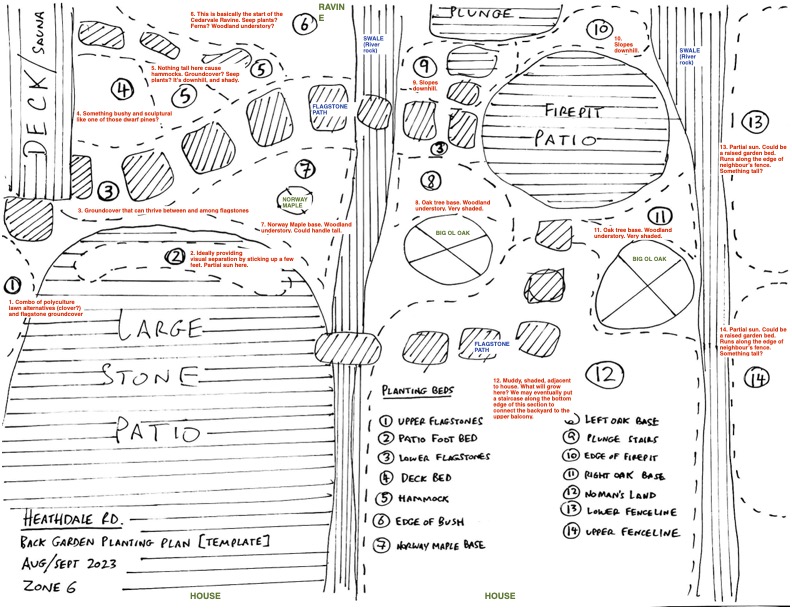
CONTEXT:
We back onto the Cedarvale Ravine. Our backyard feels like an extension of the ravine and we mostly like it that way, but last year we added an outdoor sauna set out to make the backyard a little friendlier to spend time in. We added two stone patios connected by flagstone step stones. However, between all the hardscaping it’s mostly mud, thanks to shade, neglect, and a overpowering canopy of (since reduced) norway maples.
This year, I’m determined to make it green, and to do it in a way that compounds over time, favours native & non-invasive plants, and requires minimal effort (i.e. not flowering annuals).
It’s mostly shaded, but gets partial sun in spots throughout the day. I would call it wet — when it rains it’s downright muddy if you dare step on it, especially before we added the swales to carry the downspout water into the ravine.
QUESTION:
I have a rough plan (see attached image) and I plan to order a bunch of triple mix or something, but I could use some advice about when I should be planting what?
My long-term goal is a robust & lively perennial garden that feels like a curated extension of the nature it’s embedded in.
P.S. I had to attach my image as a JPEG but I also have it as a PDF which is much easier to read and zoom.
Thank you for your question and plan. Your back garden project is a special one- backing onto an ancient ravine, albeit significantly disturbed by the 1970s subway excavations and construction. The natural forest vegetation on the sides of the ravine was left mostly intact during the subway build and the valley floor recovered well, over many decades -with the help of several groups including the Friends of Cedarvale Park, who work to keep the ravine free from invasive species, while monitoring slope erosion and tree health. They could be a useful resource to you going forward.
https://friendsofcedarvale.wordpress.com/about/upcoming-events/
It’s great to read that you are keen to create a thoughtful transition from your garden into the ravine that compliments the existing native vegetation. The local birdlife, small mammals and insects will be grateful.
The muddiness you describe in your back garden may be a consequence of compacted soil. It is possible to improve the soil drainage by improving the existing soil structure. I have added our garden guide on soil fertility for your reference below. If you read down the page to ‘soil fertility’ you will find a list of compost and mulch options- the key to increasing water absorption and leaving you with heathy soil rather than mud. The compost and mulch will trap moisture -making it available for your new plants, while allowing for natural aeration of the soil.
You mentioned building swales to carry roof runoff down into the ravine. I can see the river rock swales on you plan running directly towards the ravine. Hopefully, they turn and run across the slope, following the contour of the ravine side, to capture most of the runoff, slow its flow and allow it to soak into the hillside to be taken up by the mature trees and surrounding vegetation.
Swales are great collectors of leaf litter – which helps to trap moisture, feed the trees and further improves water absorption into, rather than down, the slope. They are mini nurseries where seed pods germinate and grow in the moist leaf litter. Swales may not be the most attractive landscape features initially, but can be planted with native grasses, shrubs and perennials to create lush islands of vegetation.
Well positioned swales provide slope stability, whereas drainage channels directly down the slope can accelerate erosion which could ultimately erode into your property. See our garden guide attached below for perennials, grasses and ground covers that would enjoy growing in your partly shady woodland ravine garden and hillside swales.
Because your site is unique and backs onto an environmentally sensitive area, a well considered planting plan would be useful. If your budget allows, a certified horticulturalist or professional garden designer can create a plant list and planting plan (showing you where every plant goes and how big they’ll get) that takes advantage of your specific light, soil and microclimate conditions, avoids invasive species and non native plants that are prolific seeders, adds slope stabilizing species and perennials with outstanding foliage, flowers, fall colour as well as plants that provide food, shelter or nesting material for birds and pollinators.
If you would prefer to do the work yourself, our native perennials for shade garden guide and native plants for habitat guide are good resources. If you are unfamiliar with many of these plants, you might find a guide with photos more useful. Under the shade garden guide list of references you will find Credit Valley Conservation (CVC)- Woodland Plants for Landscaping. CVC produce some great guides and I find that their colour photos are helpful for plant identification.
Good luck with your ravine woodland planting!
https://www.torontomastergardeners.ca/gardeningguides/native-perennials-for-shade/
April 13, 2024

